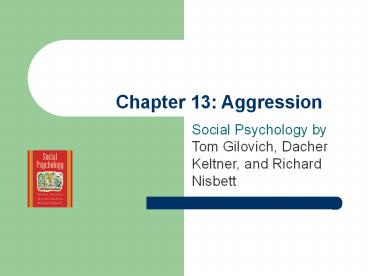Chapter 13: Aggression - PowerPoint PPT Presentation
Title:
Chapter 13: Aggression
Description:
Social Psychology by Tom Gilovich, Dacher Keltner, and Richard Nisbett Aggression Hostile aggression - behavior intended to harm another, either physically or ... – PowerPoint PPT presentation
Number of Views:129
Avg rating:3.0/5.0
Title: Chapter 13: Aggression
1
Chapter 13 Aggression
- Social Psychology by Tom Gilovich, Dacher
Keltner, and Richard Nisbett
2
Aggression
- Hostile aggression - behavior intended to harm
another, either physically or psychologically,
and motivated by feelings of anger and hostility - Instrumental aggression - behavior intended to
harm another in the service of motives other than
pure hostility (for example, to attract
attention, acquire wealth, and to advance
political and ideological causes)
3
Modern Theory of Aggression
Social Determinants
Personal Determinants
Frustration Provocation Exposure to aggressive
models Cues associated with aggression Causes
of discomfort/negative affect
High irritability Beliefs about
aggression Proaggression values Type A behavior
pattern Hostile attribution bias
Arousal
Affective States
Aggressive Cognitions
Aggression
4
Personal Determinants
- Type A behavior pattern
- Hostile attributional style
- Narcissism (inflated self-esteem)
- Gender (higher in males when not provoked)
- males tend to use direct forms (push, shove,
insult) - females tend to use indirect (gossip, spread
rumors)
Next
5
Personal Determinants
- Biological
- Instinct theory - innate (unlearned) behavior
pattern - Freud- redirecting the death instinct
(thanatos) to others - Lorenz- inherited fighting instinct developed
through the course of evolution (strongest
survive) - Neural Influences
- Genetic Influences
- Blood Chemistry
- high testosterone linked to higher aggression and
less helping - low levels of serotonin inhibit ability to
restrain aggressive urges
6
Social Determinants
- frustration
- elicits aggression esp. when cause is unjustified
- direct provocation (physical or verbal)
- exposure to media violence
- primes aggressive thoughts desensitizes viewers
- heightened arousal (provocation, exercise)
- arousal in one situation can persist and
intensify reactions in another, unrelated
situation
7
Frustration-Aggression Theory
Direct
Outward aggression
Instigation to aggress
Indirect
Frustration (Goal)
Inward aggression (e.g., suicide)
Other additional responses (e.g., withdrawal)
Back
8
Bandura, Ross, Ross
- Subjects were exposed to either aggressive or
nonaggressive models - Nonaggressive model assembled tinker toys
- Aggressive model hit Bobo doll
- Subject then spent 20 mins alone in room with
various toys including Bobo. - What did it look like?
9
Measuring Human Aggression in the Laboratory
- Buss Technique (similar to Milgrams)
- Participants (teacher) told to shock a
learner each time they made an error on a
simple learning task - Note teachers chose how strong the shocks were
- Competitive Reaction Time task (Taylor et al.)
- Participants compete with opponent on
reaction-time trials. After losing a trial, they
receive shock levels ranging in intensity from
very mild to painful. After winning a trial, they
pick shock level to administer to opponent
10
Chermack, Berman, Taylor
- Subjects competed against opponent in reaction
time game - After each trial, loser received a shock
- 2 conditions
- Low provocation - shocks stayed at setting 2
- High provocation - shocks gradually increased
from 2 to 9
Back
11
Excitation Transfer Theory
Aggression is increased
Arousal and irritation attributed to delay at gate
Frustration (delay at gate)
Meeting your future in-laws
Heightened arousal
Residual arousal
Aggression is not increased
Arousal and irritation are attributed mainly to
meeting the parents
Back
12
Situational Determinants
- high temperatures
- hotter years (and summers) increased rates of
violent crimes, but not property or rape crimes
13
Situational Determinants
- alcohol
- intoxicated participants behave more aggressively
and respond to provocations more strongly - low aggressors became more aggressive when
intoxicated, whereas high aggressors did not
14
Situational Determinants
- Media
15
Controlling Aggression
- Catharsis (blowing off a little steam)
- does not reduce aggression
- Punishment
- must be prompt, strong, and justified
- Exposure to nonaggressive models
- place prosocial models in violent situations
16
Controlling Aggression (cont)
- Cognitive interventions
- apologizing can be effective
- engage in activities that distract attention away
from causes of anger - Teach social skills
- better communication
- Induce incompatible responses
- humor
17
Study Smarter Student Website
- http//www.wwnorton.com/socialpsych
- Chapter Reviews
- Diagnostic Quizzes
- Vocabulary Flashcards
- Apply It! Exercises































